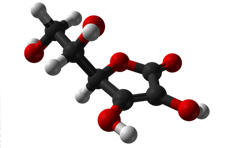







Vitamin C molecule
Vitamin C, also known as L-ascorbic acid, interferes with pigment synthesis at various oxidative steps of melanin production.
It has a reducing effect and can alter melanin from jet black to light tan.
Vitamin C interferes with melanin synthesis by reducing oxidized dopaquinone, interrupting DHICA oxidation and interacting with copper ions at the active site of tyrosinase.
Vitamin C acts as an Reactive Oxygen Spieces scavenger by donating electrons to neutralize free radicals found in the aqueous compartment of the cell.
One of the disadvantages of Vitamin C is its chemical instability in aqueous solution and its tendency to oxidize and denature. The hydrophilic nature of Vitamin C also limits its skin penetration, unless the stratum corneum barrier is disrupted.
The more stable ascorbate ester, magnesium-l-ascorbyl-2-phosphate (MAP) is more lipophilic and has a greater permeation through the stratum corneum.
>
>
>
>
>
>
>
>
>
>
>
>
>
>
>
>
>
>
TYROSINASE INHIBITORS
Polyphenols
Benzaldehyde and Benzoate Derivatives
Gallic Acid and Derivatives
Long-Chain Lipids and Steroids
INHIBITORS OF MELANOSOMAL TRANSFER
Centaureidin and Methylophiopogonanone B
Niacinamide
PAR-2 Inhibitors
Lectins and Neoglycoproteins
ANTIOXIDANTS
Glutathione
Vitamin C
Alpha Tocopherol and Alpha Tocopherol Ferulate
ACCELERATORS OF EPIDERMAL TURNOVER AND DESQUAMATORS
α-Hydroxyacids
Salicylic Acid
Linoleic Acid
Retinoids
TRANSCRIPTIONAL REGULATION OF MELANOGENIC ENZYMES
The MAPK Pathway
MC1R
cAMP Pathway and MITF

<< Previous: Glutathione
Next: Alpha Tocopherol and Alpha Tocopherol Ferulate >>